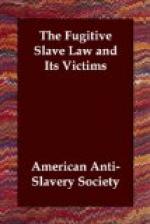JOHN HENRY WILSON, a lad of fourteen years, kidnapped from Danville, Pennsylvania, and taken to Baltimore, where he was, offered for sale to John N. Denning. Kidnappers committed to jail, October, 1852.
[—> DANIEL WEBSTER, the endorser of the Fugitive Slave Law, died at Marshfield, Mass., October 24th, 1852, in the very height of the Law’s triumphant operation.]
LOUISA, a colored woman, claimed by Mrs. Reese, of San Francisco, California, was seized by five armed men, and put on board Steamer Golden Gate, and carried it is not known whither. The aid of the Law was not invoked. The California Christian Advocate, from which the above is taken, says, “Two colored men, stewards on the Golden Gate, were sent back to the States on the last trip under the State Fugitive Law.”
A mulatto woman, in San Francisco, was ordered to be delivered to her claimant, T.T. Smith, Jackson Country, Missouri, by “Justice Shepherd,”—San Francisco Herald—in Standard, November 4, 1852.
Sandusky, Ohio. Two men, two women, and several children were arrested and taken from a steamboat just about to leave for Detroit. Taken before Mayor Follett, by a man who claimed to be their owner. R.R. Sloane, Esq., was employed as counsel for the slaves. No one claiming custody of the slaves, or producing any writs or warrants, Mr. Sloane signified to the crowd present that there appeared to be no cause for the detention of the persons. Immediately a rush was made for the door. A man, who before had been silent, exclaimed, “Here are the papers—I own the slaves—I’ll hold you individually responsible for their escape.” The slaves escaped into Canada, October, 1852. Mr. Sloane was afterwards prosecuted for the value of the slaves, and judgment given against him to the amount of $3,950.
Thirty slaves, says the Maysville (Ky.) Eagle, “escaped from Mason and Bracken Counties, a short time ago. Some of them were captured in Ohio, by their owners, at a distance of about forty miles from the river.” “They brought the captured slaves home without encountering the least obstacle, or even an unkind word.”—Standard, November 4, 1852.
THE LEMMON SLAVES. At New York, eight persons, claimed by Jonathan Lemmon, of Norfolk, Virginia, as his slaves, were brought before Judge Paine, November, 1852. It appeared that they had been brought to New York by their owner, with a view of taking them to Texas, as his slaves. Mr. Louis Napoleon, a respectable colored man, of New York, procured a writ of habeas corpus, under which they were brought before the court. Their liberation was called for, under the State Law, not being fugitives, but brought into a free State by their owner. Said owner appeared, with Henry D. Lapaugh as his counsel, aided by Mr. Clinton. At their urgent request, the case




